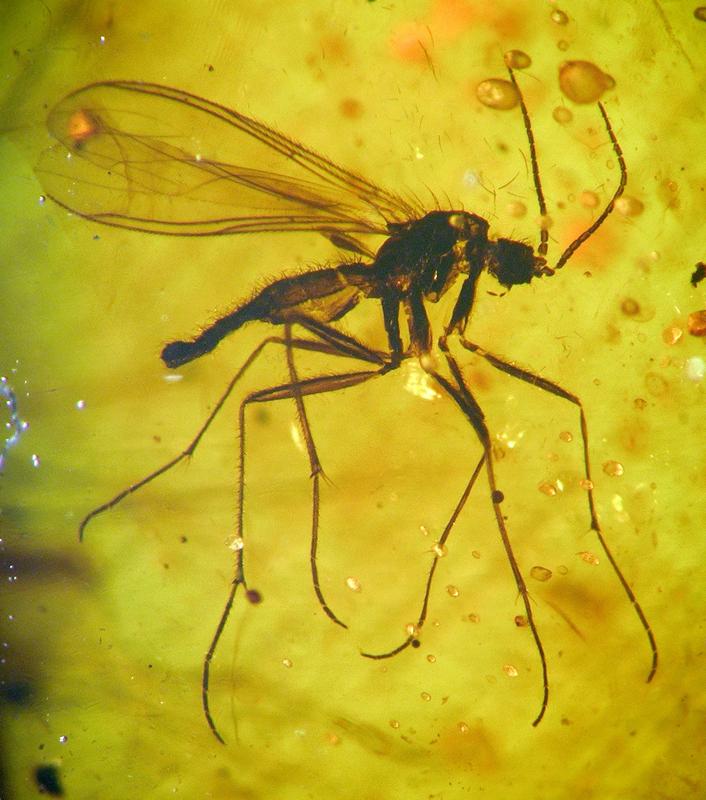Chinese mosquitos on the Baltic Sea

Konserviert in einem goldenen Sarg: Trauermücke eingebettet in Fushun-Bernstein. Foto: Bo Wang / Universität Bonn
This is what amber, which was found in East China showed, in whose analysis the University of Bonn is currently participating. The fossil resin clumps give evidence of arthropods from more than 80 different families, constituting a unique snapshot of East Asia's insect universe at the time.
The analysis of the roughly 3,000 pieces is still in its infant stage. But it is already evident that the results will be of major significance. “Amazingly often, we are finding–in addition to Asian forms–the same insect species in Fushun amber that we found in Baltic amber,” explained Bonn paleontologist Professor Dr. Jes Rust.
The Baltic amber comes from the Baltic Sea region, which is almost 10,000 kilometers from Fushun. Sites rich in finds are, e.g., the coastal regions of Mecklenburg, Poland and Belarus. The pieces from the Baltic region are slightly younger than the ones from Fushun–according to estimates, about 40 to 50 million years.
At that time, Europe and Asia were divided by the Strait of Turgay, a wide arm of the ocean. Many researchers had assumed until now that this body of saltwater prevented species migrations between the continents–or at least, made it much harder. “Consequently, the great similarity of the included insects has been a great surprise to us,” said Rust. “We don't know yet how that fits together.”
A neglected treasure
In the vicinity of the Northeast Chinese city of Fushun, there are large lignite deposits. Humans have been digging up this fuel from the ground for more than a century already. And in doing so, they also kept finding pieces of amber. Traditionally, the locals made jewelry from it. Particularly beautiful finds with interesting inclusions are highly sought after among collectors.
Until now, the inclusions had not been studied systematically. It was the Chinese paleontologist Dr. Bo Wang who finally recognized the scientific potential of Fushun amber. Wang, who is currently at the Bonn University on a research grant from the Alexander von Humboldt Foundation, used his good contacts with institutes and collectors to start systematically cataloguing the finds. An analysis is currently underway in collaboration with paleontologists from Europe and the USA.
And it is beginning to become clear how rich this deposit is. So far, the researchers have been able to identify arachnids and insects from more than 80 families–a snapshot of the past that provides a detailed view of what tiny animals populated East Asia 53 million years ago.
In addition, the Fushun deposit is filling in one of the blank spots on the map. With the exception of India, it constitutes the only significant site where amber has been found in Asia. Rust regrets that the open pit mining in Fushun will soon stop. “But despite that, the detailed analysis of the finds will probably keep us busy for quite some time.”
Publication: Bo Wang, Jes Rust, Michael S. Engel, Jacek Szwedo, Suryendu Dutta, André Nel, Yong Fan, Fanwei Meng, Gongle Shi, Edmund A. Jarzembowski, Torsten Wappler, Frauke Stebner, Yan Fang, Limi Mao, Daran Zheng and Haichun Zhang; A Diverse Paleobiota in Early Eocene Fushun Amber from China; Current Biology 24 (2014); http://dx.doi.org/10.1016/j.cub.2014.05.048
Contact:
Dr. Bo Wang
Steinmann-Institute of the University of Bonn
and State Key Laboratory of Palaeobiology and Stratigraphy
Nanjing Institute of Geology and Palaeontology
Chinese Academy of Sciences (Nanjing/China)
Phone: +86 13951982860
Email: savantwang@gmail.com
Prof. Dr. Jes Rust
Steinmann-Institute of the University of Bonn
Phone: +49 228/734842
Email: jrust@uni-bonn.de
Media Contact
More Information:
http://www.uni-bonn.de/All latest news from the category: Life Sciences and Chemistry
Articles and reports from the Life Sciences and chemistry area deal with applied and basic research into modern biology, chemistry and human medicine.
Valuable information can be found on a range of life sciences fields including bacteriology, biochemistry, bionics, bioinformatics, biophysics, biotechnology, genetics, geobotany, human biology, marine biology, microbiology, molecular biology, cellular biology, zoology, bioinorganic chemistry, microchemistry and environmental chemistry.
Newest articles

Security vulnerability in browser interface
… allows computer access via graphics card. Researchers at Graz University of Technology were successful with three different side-channel attacks on graphics cards via the WebGPU browser interface. The attacks…

A closer look at mechanochemistry
Ferdi Schüth and his team at the Max Planck Institut für Kohlenforschung in Mülheim/Germany have been studying the phenomena of mechanochemistry for several years. But what actually happens at the…

Severe Vulnerabilities Discovered in Software to Protect Internet Routing
A research team from the National Research Center for Applied Cybersecurity ATHENE led by Prof. Dr. Haya Schulmann has uncovered 18 vulnerabilities in crucial software components of Resource Public Key…





















